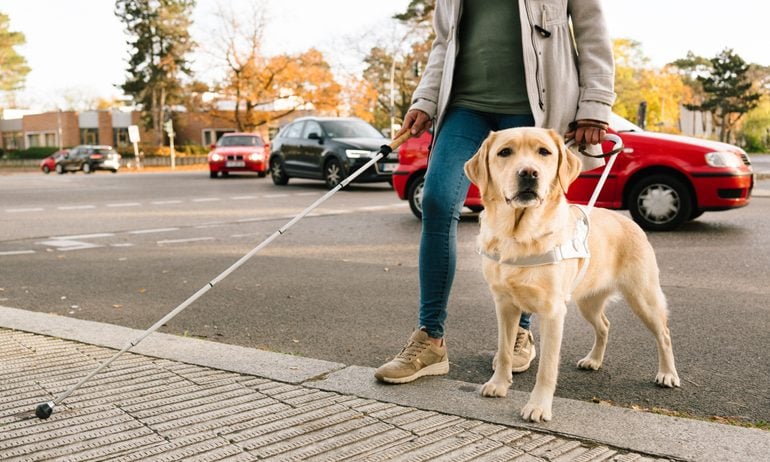Social Security Disability Insurance (SSDI) Benefits: Basics, How to Apply
SSDI provides financial assistance to people who can’t work due to a disability, but your condition has to qualify.

Many, or all, of the products featured on this page are from our advertising partners who compensate us when you take certain actions on our website or click to take an action on their website. However, this does not influence our evaluations. Our opinions are our own. Here is a list of our partners and here's how we make money.
The investing information provided on this page is for educational purposes only. NerdWallet, Inc. does not offer advisory or brokerage services, nor does it recommend or advise investors to buy or sell particular stocks, securities or other investments.
You have to meet strict criteria to qualify for SSDI benefits, including having paid Social Security taxes.
The SSA pays SSDI benefits monthly if you qualify.
How much the SSA pays you depends on your work and earnings history.
SSDI is meant to help you afford necessities — benefits tend to be just above federal poverty level income.
You have to meet strict criteria to qualify for SSDI benefits, including having paid Social Security taxes.
The SSA pays SSDI benefits monthly if you qualify.
How much the SSA pays you depends on your work and earnings history.
SSDI is meant to help you afford necessities — benefits tend to be just above federal poverty level income.
What is SSDI?
Social Security Disability Insurance (SSDI) is a government-sponsored benefits program that provides financial assistance to people with qualifying disabilities. In September 2024, the average monthly payment was $1,539.84. The maximum monthly SSDI benefit is $4,018 in 2025.
How much SSDI you qualify for depends on your primary insurance amount (PIA), which is based on your average inflation-indexed earnings over your highest-paid 35 years of qualifying work, also known as your average indexed monthly earnings (AIME). In September 2024, nearly 7.3 million people received SSDI.
How does SSDI work?
The Social Security Administration (SSA) provides monthly SSDI income to people who cannot work for a year or more due to a disability. The SSA’s definition of disability is strict and doesn’t apply to conditions that other programs or agencies might classify as disabilities.
If you qualify for SSDI, you’ll receive payments electronically to a bank account through direct deposit or onto a Direct Express Debit Mastercard. In extremely rare cases, a beneficiary may be allowed to collect benefits outside of electronic payments. The payments arrive on a monthly schedule.
From time to time, the SSA will review your disability and its effect on your ability to work. How often it reviews your condition depends on if your disability is likely to improve and allow you to return to work. As long as you have a qualifying health condition and cannot work routinely, you may continue to receive SSDI benefits.
SSDI is not the same as Supplemental Security Income (SSI). SSDI is for workers who are unable to work because of a qualifying disability, and SSI is for people who are unable to afford basic necessities such as food and shelter due to low income and age or disability.
How much does SSDI pay?
The maximum monthly SSDI benefit is $4,018 in 2025. However, the average monthly SSDI benefit in September 2024 was $1,539.84, which is $2,282.16 less than the 2024 maximum benefit.
SSDI benefits are based on several factors, including how much the person has contributed to Social Security through Social Security taxes on their past earnings. If you have not worked long enough in jobs that deducted Social Security taxes from your paychecks or within a certain timeframe, you might not qualify for SSDI.
SSDI payments automatically increase if the SSA issues an annual cost-of-living adjustment (COLA), which tracks changes based on the consumer price index. This helps SSDI payments keep up with inflation. The Social Security cost-of-living adjustment (COLA) for 2025 will be 2.5%.
The Social Security Administration uses a weighted benefit formula so that lower earners may get comparatively higher benefits than higher earners.
SSDI also pays limited benefits to families of disabled workers. Qualifying families can receive up to 85% of the worker’s average indexed monthly earnings, but the benefit must be between 100% and 150% of the worker’s primary insurance amount.
SSDI benefits are meant to help you with basic needs. As such, the average SSDI payment is only slightly higher than the poverty line. The average SSDI benefit for September 2024 was only $284 above the 2024 federal poverty level of $1,255 per month for individuals.
» Learn more: Will my disability benefits change at retirement age?
Your SSDI benefits will switch to your Social Security retirement benefits once you reach full retirement age. The amount will remain the same, but you will no longer have to undergo disability reviews to ensure you continue to qualify for SSDI.
Who qualifies for SSDI?
To qualify for SSDI benefits, you must have:
Worked and paid Social Security taxes. Depending on your age when you developed a disability, you’ll need to have worked for a certain amount of time in a qualifying job to be eligible for SSDI.
A qualifying medical condition. You can view the SSA's complete disability evaluation listings to see if your condition qualifies. Different rules apply if you are blind or are applying for survivor's benefits.
Inability to perform substantive work for at least 12 months. To be eligible for SSDI, you must be unable to perform any type of work because of your disability. If you can’t do your previous work but can do a job in a different industry, you likely won’t qualify for SSDI.
Monthly income below the substantial gainful activity limit. You’ll need to show that you earn less than what the SSA considers substantial gainful activity (SGA). The substantial gainful activity limit for 2025 is $1,620 per month ($2,700 if blind).
» MORE: Is disability income taxable?
How long does it take to get SSDI?
It usually takes three to six months (but can take longer) for the SSA to review your application and records to determine if you have a qualifying disability . If you are denied and appeal the decision, you will have to wait longer for a second decision.
Once you are approved, the typical waiting period to receive benefits is five months. The SSA may pay benefits retroactively if it finds that you were eligible. However, the five-month waiting period may be waived if you previously qualified for SSDI benefits.
» Learn more: What is the Social Security disability 5-year rule?
How to improve your chances of receiving SSDI benefits
Though these standards may seem straightforward, in 2022 the Social Security Administration denied 62% of initial applications. The following tips might increase your qualification chances:
Keep proper medical records. Include paperwork of your treatments and doctor visits throughout the history of your disability. Continue to gather this information as you go through the application process to help prove your case.
Demonstrate an effort to return to work. This includes following doctors' orders, seeing specialists and trying new treatments when prescribed. The SSA wants to see that applicants are doing everything possible to reenter the workforce, even after they've applied for SSDI.
Log into your Social Security account. See how many work credits you've earned by logging into your account. You generally need 40 work credits to qualify, with 20 credits earned in the last 10 years, ending in the year your disability started. However, credits can vary depending on your age.
Consider getting a lawyer. A disability lawyer can help you keep up with deadlines and provide further advice to help you with your case. Federal law requires that they aren’t paid unless you are awarded benefits, and there is a cap on how much they can charge. If you appoint an attorney, notify the SSA through Form SSA-1696 (Appointment of Representative form).
» Learn more: Three signs you'll be approved for SSDI
How to apply for SSDI
You can apply for SSDI benefits over the phone, at your local Social Security office or by filling out an application on the SSA website. However, you cannot apply online if:
You are under 18 years old.
You are currently receiving Social Security benefits that are based on your own work record.
The SSA has denied your application for SSDI in the past 60 days.
You’ll submit a lot of documentation with your application, including:
Proof of your identity and citizenship status such as a birth certificate.
Medical records and documentation of your treatments, physician visits and therapy sessions, including contact information for doctor offices and caseworkers.
A list of your current medications along with dosages.
Other records relating to your condition outside of your standard provider, such as vocational rehab records and workers’ compensation benefits.
Information about your current or ex-spouse if applicable. This may include information about your marriage or divorce.
Names and dates of birth for dependent children.
Work history including your last two years of employment, including self-employment and the types of jobs you’ve worked in the past.
Your most recent W-2 or federal tax return.
Educational history, including trade and vocational training.
Banking information for direct deposit.
Military records if applicable.
When you apply for SSDI, you’ll need to access or attempt to create a my Social Security account. Use the document in Step 1 below to set up a new account.
To apply for SSDI:
Review the SSA’s Adult Disability Checklist to ensure you have all of the information you need.
Fill out the SSDI application. You can fill it out and submit it online or download it and print a hardcopy.
Fill out and submit Form SSA-827 “Authorization to Disclose Information to the Social Security Administration (SSA).” This is a medical release form.
4 tips for applying for SSDI benefits
Apply as soon as you become disabled and believe you are eligible to receive SSDI.
Gather your information ahead of time. Don’t wait until you are filling out the form to request records and copies of documentation. Go ahead and start getting everything together ahead of time to make the process easier as you fill out the application.
Prepare an account of your medical and work history so that the reviewer for your case can understand how your condition affects your ability to work.
Keep a history of everyone you speak to during the process. If you can refer back to notes that include who you talked to, on what date, and about which part of your application, you'll avoid missing key details that could keep your case from moving forward.
» Learn more: When to apply for Social Security and how

